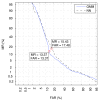A Knowledge-Based Approach to Automatic Detection of Equipment Alarm Sounds in a Neonatal Intensive Care Unit Environment
- PMID: 29404227
- PMCID: PMC5788405
- DOI: 10.1109/JTEHM.2017.2781224
A Knowledge-Based Approach to Automatic Detection of Equipment Alarm Sounds in a Neonatal Intensive Care Unit Environment
Abstract
A large number of alarm sounds triggered by biomedical equipment occur frequently in the noisy environment of a neonatal intensive care unit (NICU) and play a key role in providing healthcare. In this paper, our work on the development of an automatic system for detection of acoustic alarms in that difficult environment is presented. Such automatic detection system is needed for the investigation of how a preterm infant reacts to auditory stimuli of the NICU environment and for an improved real-time patient monitoring. The approach presented in this paper consists of using the available knowledge about each alarm class in the design of the detection system. The information about the frequency structure is used in the feature extraction stage, and the time structure knowledge is incorporated at the post-processing stage. Several alternative methods are compared for feature extraction, modeling, and post-processing. The detection performance is evaluated with real data recorded in the NICU of the hospital, and by using both frame-level and period-level metrics. The experimental results show that the inclusion of both spectral and temporal information allows to improve the baseline detection performance by more than 60%.
Keywords: Acoustic event detection; alarm detection; neonatal intensive care unit; neural networks; non-negative matrix factorization; sinusoid detection.
Figures







Similar articles
-
Types and Frequency of Infusion Pump Alarms and Infusion-Interruption to Infusion-Recovery Times for Critical Short Half-Life Infusions: Retrospective Data Analysis.JMIR Hum Factors. 2019 Aug 12;6(3):e14123. doi: 10.2196/14123. JMIR Hum Factors. 2019. PMID: 31407667 Free PMC article.
-
Optimisation of clinical workflow and monitor settings safely reduces alarms in the NICU.Acta Paediatr. 2021 Apr;110(4):1141-1150. doi: 10.1111/apa.15615. Epub 2020 Oct 22. Acta Paediatr. 2021. PMID: 33048364 Free PMC article.
-
Epidemiology of patient monitoring alarms in the neonatal intensive care unit.J Perinatol. 2018 Aug;38(8):1030-1038. doi: 10.1038/s41372-018-0095-x. Epub 2018 May 8. J Perinatol. 2018. PMID: 29740183 Free PMC article.
-
Impact of Alarm Fatigue on the Work of Nurses in an Intensive Care Environment-A Systematic Review.Int J Environ Res Public Health. 2020 Nov 13;17(22):8409. doi: 10.3390/ijerph17228409. Int J Environ Res Public Health. 2020. PMID: 33202907 Free PMC article.
-
Auditory brain development in premature infants: the importance of early experience.Ann N Y Acad Sci. 2012 Apr;1252:17-24. doi: 10.1111/j.1749-6632.2012.06445.x. Ann N Y Acad Sci. 2012. PMID: 22524335 Review.
Cited by
-
Implementation and Operational Analysis of an Interactive Intensive Care Unit within a Smart Health Context.Sensors (Basel). 2018 Jan 29;18(2):389. doi: 10.3390/s18020389. Sensors (Basel). 2018. PMID: 29382148 Free PMC article.
-
Extraction of Premature Newborns' Spontaneous Cries in the Real Context of Neonatal Intensive Care Units.Sensors (Basel). 2022 Feb 25;22(5):1823. doi: 10.3390/s22051823. Sensors (Basel). 2022. PMID: 35270967 Free PMC article.
References
-
- Hassanein S. M. A., El Raggal N. M., and Shalaby A. A., “Neonatal nursery noise: Practice-based learning and improvement,” J. Mater.-Fetal Neonatal Med., vol. 26, no. 4, pp. 392–395, 2013. - PubMed
-
- Krueger C., Wall S., Parker L., and Nealis R., “Elevated sound levels within a busy NICU,” Neonatal Netw., vol. 24, no. 6, pp. 33–37, 2005. - PubMed
-
- Wachman E. M. and Lahav A., “The effects of noise on preterm infants in the NICU,” Arch. Disease Childhood-Fetal Neonatal Ed., vol. 96, no. 4, pp. F305–F309, 2010. - PubMed
-
- Gray L. and Philbin M. K., “Effects of the neonatal intensive care unit on auditory attention and distraction,” Clin. Perinatol., vol. 31, no. 2, pp. 243–260, 2004. - PubMed
LinkOut - more resources
Full Text Sources
Other Literature Sources

